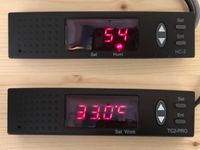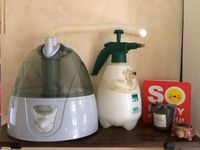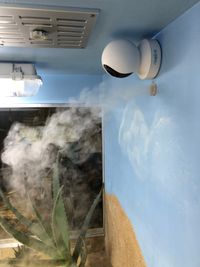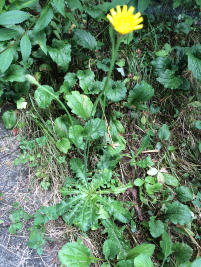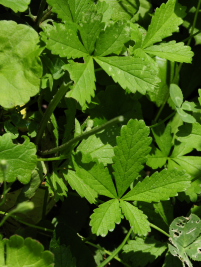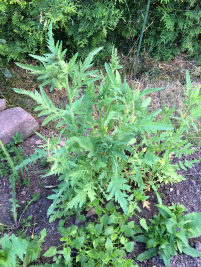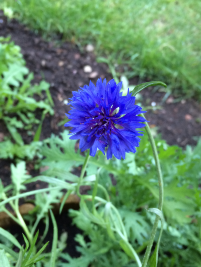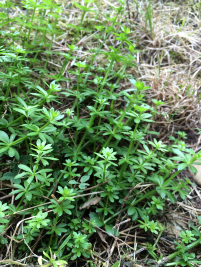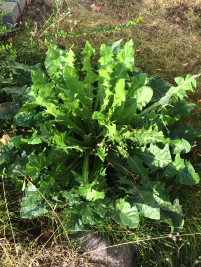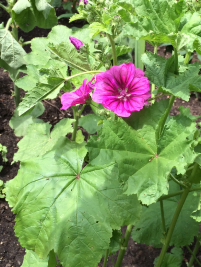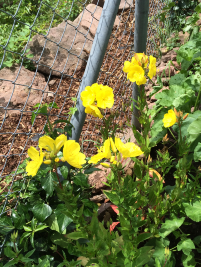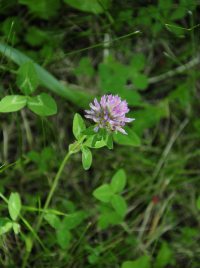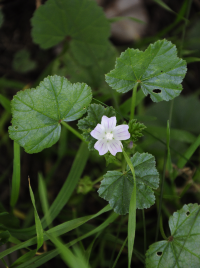Terrarium
In the following subcategories I report about the maintenance of my animals in the terrarium. I would like to emphasize that my way of keeping is just ONE of several possibilities. I make no claim to the absolute correctness of the kind of ministration I practice. I try to design the habitat in the terrarium for my animals, as far as possible, with orientation towards nature. In principle I follow the climate gradients of different places in Libya, Egypt and Israel and offer my animals a similar climate derived from them. The nutrition and the equipment in the terrarium I design to be as close to nature as possible.
I keep my animals in a self-built terrarium system made of 12 mm multiplex birch panels and 19 mm 3-layer spruce panels. Sturdy kitchen base cabinets from IKEA in various sizes serve as the substructure. Overall, the system consists of a 200 x 100 cm leg (group 1), which acts as a room divider, and a 350 x 80 cm leg (group 2 and offspring). During the planning, I paid particular attention to the room climate in my living room, easy access to every part of the terrarium and the Egyptian tortoises' willingness to run. With the size of the facility, I would like to offer the animals as much space as my living situation currently allows. The available space is used very happily and extensively by all animals.
How I create the climate in the terrarium
To create a habitat-like climate in my terrarium, I use some special technique. In some countries, the following technical devices and bulbs are readily available, but unfortunately not in other countries. That's why I can only talk about my own methods in this topic. Unfortunately, I do not know what is possible in your country.
Temperature control
For measuring and controlling the temperatures, I use a thermostat with a long cable sensor, which I have installed in the terrarium at the coolest place. Mainly I use the display of the temperature for monitoring. I only use the regulating function for the particularly hot summer months of July and August and, if necessary, switch on Elstein (ceramic heat emitters) to reach the high summer temperatures. The room temperature of my apartment is also in midsummer never over 25 °C, even when it has a longer time over 30 °C outside. In cold summers, which have already occurred, my apartment remains quite cool, so that I do not reach the required summer temperatures with the UV and heat lamps, despite the covered terrarium. Then the Elstein help to increase the temperatures to provide more summer heat for the aestivation. The temperatures in the fall, winter and spring I regulate exclusively by removing the covers and in particular at night about lowering the room temperature. During the day, I reach about 22-23 °C in this way, at a room temperature of 18 °C. At night I reach a minimum temperature of 16-17 °C, by turning off the heating and tilting the nearest window. Currently I'm still looking for ways to get closer to the temperatures in the habitat at these seasons.
Humidity and rain
To regulate and measure humidity, I use a humidity controller, also with a long cable sensor attached to one side of the terrarium. The humidity controller offers me the opportunity to enter the values I want for day and night. I connected a fogger to the humidity controller. Together, the two devices provide a constant relative humidity according to the values I have entered. I simulate rainfalls with a hand sprayer. For that I base the frequency of rain showers on the climate data of Libya, Egypt and Israel.
Lightning
The lighting consists of a basic lighting for daylight and UV heat lamps that emit a very bright light, lots of heat and UV light. The basic lighting is provided by T5 LED tubes, basking areas are illuminated by UV metal halide lamps. All lamps are switched on via timers, in order to simulate the day and to control the temperatures.
Setup and structuring
Since the Egyptian tortoises live in their natural habitats on strongly consolidated sandy soils, or on relatively loose dune sand, I use in the terrarium a mixture of sand and a small amount of clay, mixed in a ratio of 5:1 (sand:clay). I introduced a total of 250 kg of substrate in varying heights between 5-15 cm.
In order to structure the artificially created habitat of my tortoises, I have integrated different plants directly into the soil. At the roots, I left a little bit of the earth from the pot they were planted in, when I integrated them into the sandy soil. In fall, winter or spring, some of my Egyptian tortoises like to dig themselves shallow hollows at the roots of plants and use them as a place to sleep. During the summer rest, they prefer the caves, which I have built from halved clay pots. These caves simulate the rodent burrows and tunnels served by the tortoises in the wild. The ovipositions are so far mainly in nests, which were dug directly on the root ball of a plant, rarely under stones or in the clay caves. There the ground is always slightly damp due to the regular watering of the plants and is heated by the outer edge of the light beam of the UV and heat lamps. Plants, roots, stones and caves also serve as hiding places or visual barriers. For climbing, I built flat terraces of sandstones. The plants, stones and terraces are extensively used for "hiking" and climbing.
Diet and water
In autumn, winter and spring, my animals are fed almost daily. From time to time I also drop the feeding for a day. The food portions for my group of 5 Egyptian tortoises are about a handful in amount. As long as available outdoors, I only feed fresh wild herbs. Dried wild herbs are always available for them throughout the year. If fresh wild herbs are no longer available outside, I feed moistened romaine lettuce, chicory or endive, which are sprinkled with dried wild herbs to enhance the nutritional value of the food. Also flowers or leaves of Schlumbergera truncata or Callisia repens are a very popular food for my tortoises. During summer rest, only dried wild herbs and flowers are offered. In a corner of the terrarium, I have created a small bed, where I sow wild herbs in winter. So I can offer, in addition to the salads, fresh young wild herbs, and thus enhance the food.
Unfortunately, I do not know which suitable wild herbs grow in your country, so I can not give any recommendations at this point.
Some plants I feed
As a calcium supplement, cuttlebones are always available to my tortoises in various forms (in whole pieces how they are extracted from the cuttlefish, broken into small pieces, grated or pulverized). Also pure algal lime powder without vitamin supplements can be offered for calcium supply. Especially hatchlings and juveniles take algal lime powder mostly better than powdered cuttlefish. Calcium, in conjunction with UVB light, is important for the bones and the carapace. In a varied diet, vitamin additions are not necessary. Vitamin additions can lead to overdoses, and thus to serious diseases. Should vitamin administrations be necessary, these must be discussed with a veterinarian.
The food is served on a slate plate, which is taken out of the terrarium at regular intervals for cleaning and disinfection. I pour bubbly boiling water over it and then heat it for 15 minutes in the oven at 250 ° C.
The diet also includes the water balance, or rather drinking. My tortoises only drink water, which drips from simulated rain showers of plants and stones or the carapace of each other. Twice a year, with the last rain shower before the summer rest and right after the summer rest, I offer a long bath, if it is possible in the natural sunlight on my terrace. During the bath they drink extensively. My Testudo kleinmanni will only receive additional baths if I feel that it is necessary, for example for medical reasons. I do not provide water bowls. Since there are no stagnant waters or puddles in nature, the provision of water bowls seems to me unnatural. But that's just my own opinion, which does not mean that you should not do that. Of course, you can provide water bowls if you want.
The cycle of the year and aestivation time
I simulate the annual cycle with short days in winter and long days in summer, active time and summer rest on the lamp control, the nutrition, temperatures and humidity values. All these factors play a very important role in the biorhythm of Testudo kleinmanni. Both, for the health of the animals as well as for a successful breeding, this biorhythm is very important.
A very important point in the annual cycle of Testudo kleinmanni is the summer rest (aestivation). Due to the lack of rainfall from about mid-April the already barren vegetation of the steppe increasingly dehydrates. The water and fresh food supply drops to virtually zero, except for a small early morning dew - probably the only way for the animals to drink a few dew drops from the arid plants in the very early morning or late evening hours, and slightly to eat from the dried plants. As soon as the sun rises over the horizon, the temperatures rise quickly and within a very short time the dew is dried off. Then the Egyptian tortoises retreat to deeper underground rodents to protect themselves from dehydration, as these rodents offer not only a milder climate than it is on the surface, they also provide the tortoises a higher level of hydration that they can absorb through skin and shell, too. Despite the prolonged drought due to the lack of rainfall, the relative humidity in the habitats of Testudo kleinmanni is also quite high at around 60% during the day. This is explained by the proximity to the Mediterranean coast. At night, the relative humidity, especially in the early morning hours, can rise to over 80%, making the morning dew possible. These climatic conditions must be taken into account when keeping Egyptian tortoises in human custody.
As I already mentioned, I simulate the summer rest, taking into account all factors from the nature model. In the month of May, I reduce the amount of fresh food weekly, until finally at the beginning of June, I only offer dried wild herbs and blossoms as food. An extensive water bath in the natural sun on my terrace, serves my animals to replenish their water reserves before the dry period. Temperatures rise steadily in the terrarium from April to August, rains will no longer be simulated from mid-April, the daylight length (basic lighting) and sunshine duration (UV metal halide lamps) will increase bit by bit. Nevertheless, I offer humidity levels around 60% during the day, and at night the relative humidity increases to about 75%, so that a bit of dew can form on the stones under the nebulizer from which my Egyptian tortoises occasionally drink. Most of the caves, I have built below the actual floor level on which the tortoises usually run. On the right and on the left side of the shelters, I have integrated plants, through irrigation they are kept wetter than the surroundings.
I observe the behavior of my animals very closely, even when I'm away from home via a webcam. In the time of aestivation especially my females and the two juveniles are often awake in the early morning hours to eat from the dried wild herbs and occasionally drink from the condensation water on the stones below the nebulizer. After about two hours they go to hide in their caves. My male, however, rests much more consistently, he usually disappears from about mid-May, when the temperatures have reached the 30 ° C mark, in a shelter and rests there very strictly. Very rarely, at intervals of about three weeks, he comes out in the early morning, makes a few small rounds, eats something and disappears after 30 minutes at the safe hiding place again.
Although I let the temperatures drop a little from the beginning of September, as it is the case in the habitats, this is not enough to end the resting period. At the end of September/beginning of October, I finish the summer rest with a powerful rain shower from the sprayer. Immediately all my tortoises come out of their hiding places, to welcome the rain by greedily drinking the water from everywhere. After the first big rainstorm, all my tortoises are bathed extensively, if the temperatures allow it even outside in the natural sun on my terrace. In October, I start again with the addition of fresh food, the amount is increased weekly until the end of October, until again dry and fresh food is available daily. The frequency of rain showers increases from month to month until January and then slowly decreases until April. Of course, I also adjust the day length and sunshine periodically. And then the cycle starts from the beginning ...
